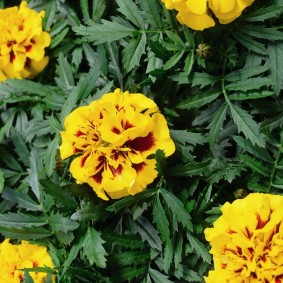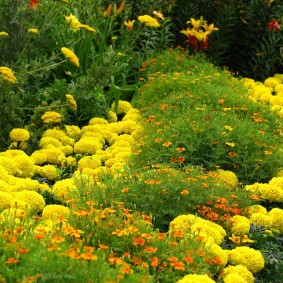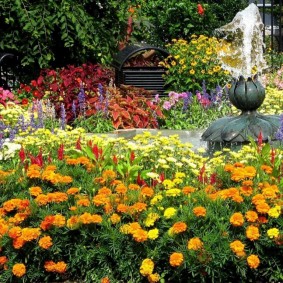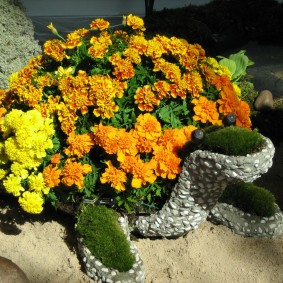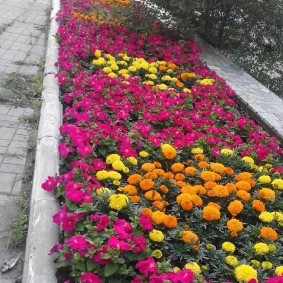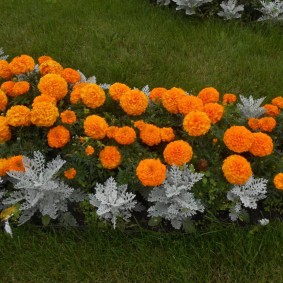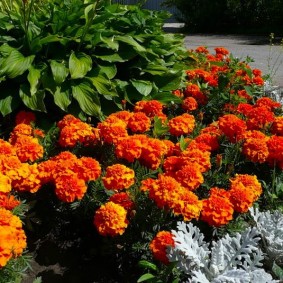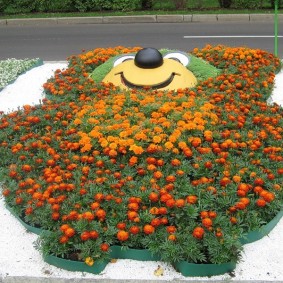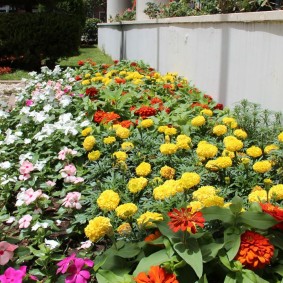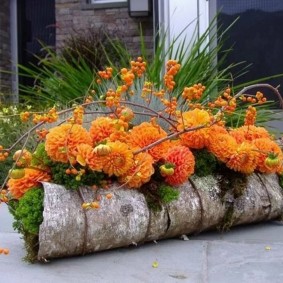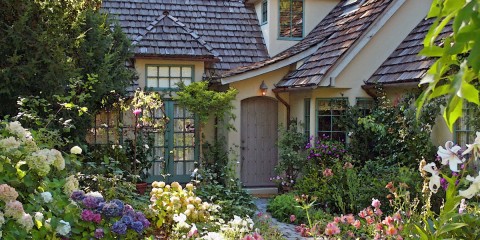 Landscape design
Lighting options for a country house and a summer cottage
Landscape design
Lighting options for a country house and a summer cottage
Marigolds (in Latin - Tagetes, on behalf of the grandson of Jupiter) symbolize longevity in many countries. The plant is often called Turkish cloves or black mane. These flowers are one of the universal flyers, without which it is impossible to imagine any landscape design, no garden plot, no cottage. On the territory of Russia they grow everywhere except the Far North. Homeland - America, where they are now found in the wild. Elegant and bright, uplifting spectacular flower beds of marigolds delight the eye with decorative buds throughout the summer season.

Due to their unpretentiousness and high decorativeness, marigolds are enviable among gardeners.
Description of colors
Content
The stems of a plant belonging to the Asteraceae family are erect or branched, with a height of 20 to 130 cm, with a fibrous root system. Leaves - from light to dark green, cirrus-separated, with well-visible structural veins, decoratively decorated along the edge with denticles. Baskets of various shades: yellow, orange, brown - have a diameter of 4-6 cm, velvety in appearance, often two or three-colored.

Marigolds - a representative of annual plants with a fairly powerful root system and a branched above-ground part
Marigolds in the flowerbed, as in the photo, successfully entered into the landscape design, look wonderful for a long period - from June to frost. Seeds give self-seeding and germinate over 3-4 years. Tageteses owe their spicy smell rather to foliage - it smells stronger than buds.

The specific aroma of marigolds repels insect pests, so bushes with orange flowers can often be seen among the garden beds
The plant was used by the Indians in medicine and cooking, and now it is widely used in cosmetology in the manufacture of face masks and hair rinses. Of the petals, leaves, buds of some types of flowers, they often get seasoning added to salads, first courses, meat.

Marigold flowers have long been featured in folk recipes for various diseases
Main varieties
Marigolds are classified according to several parameters.
Bush height (in cm):
- Giant - 90-120. They are used as background fill or as a border for landscape design of a flower bed.
- High - 60-90. The functional purpose of the plant is the same.
- Medium - 45-60. They plant the middle parts of mixborders or monocultural flower beds.
- Low - 25-45. They are used for planting along the edges of paths, as well as filling voids near single perennial flowers.
- Dwarf - up to 20. They are often used on mini-beds or as an element of landscape design in the form of carpet.

Winding “path” of low marigolds

Tall marigolds along a wooden picket fence
Number and shape of flower petals:
- cloves - have a reed configuration;
- chrysanthemum - tubular, large;
- anemone, combined from the previous two.
The following types of marigold flowers are also distinguished:
- Rejected or French. A small height (from 15 to 60 cm) perennial plant has two or three-color buds, dark green foliage.It blooms from June to September, the peak of flowering occurs at the end of August.
- Upright, called African. These are shrubs of different branches, with a height of 40 to 110 cm, with unpaired dentate leaves. Petals are simple or terry, often monophonic. The inflorescences are large, 5-15 cm in diameter. The life of marigolds in the flower bed is from July to mid-autumn.
- Thin-leaved species form low, not more than half a meter, bushes with small dissected leaves. Flowers of a small size - from 1 to 3 cm - often have a frame around the edges of a different shade. These plants delight with their beauty the longest - from the beginning of June to frost.
The use of marigolds in landscape design
They do not require special care (the only condition is good illumination of the flowerbed), they easily tolerate a transplant, even with buds.

The rule "plant before, bloom earlier" is quite suitable for marigolds. Therefore, experienced gardeners grow them through seedlings
Marigolds are used:
- in the form of colorful blotches;
- to add contrasts;
- upon reaching the lace effect;
- to mask the flaws of wilted plants in the flowerbed;
- they are surrounded by tall perennials and beautiful shrubs;
- as a placeholder for voids;
- as an auxiliary emphasis;
- to decorate park paths or playgrounds.
Marigold flowers are a universal flyer, therefore they look good on lawns, successfully fit into classical garden design curtains, various mixborders, carpet and patterned. They can be used in the design of the landscape based on the past, projects of the modern type, historical imitations, they will come in handy when embodying a lush or minimalist image of a flowerbed decor.

Flower beds can consist of marigolds of different varieties or combined with other ornamental plants
Creating a flower garden of marigolds of a simple geometric shape is the best option for a novice florist. Plants with large buds, when planted at least 25 cm, create the appearance of a continuous coating. The addition of monochrome plantings with a contrasting shade will bring diversity and originality to the landscape design.
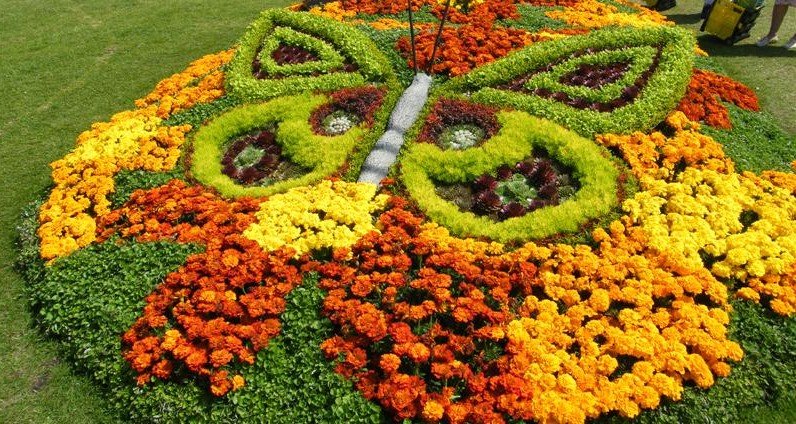
Using marigolds of contrasting colors, you can create various patterns on the flower beds
It would seem that marigolds, photos of flowers in the flowerbed are presented in the photo gallery for the Japanese rock garden, they are not suitable. But a colorful asymmetric interspersing shades the harsh charm of the rocky landscape.
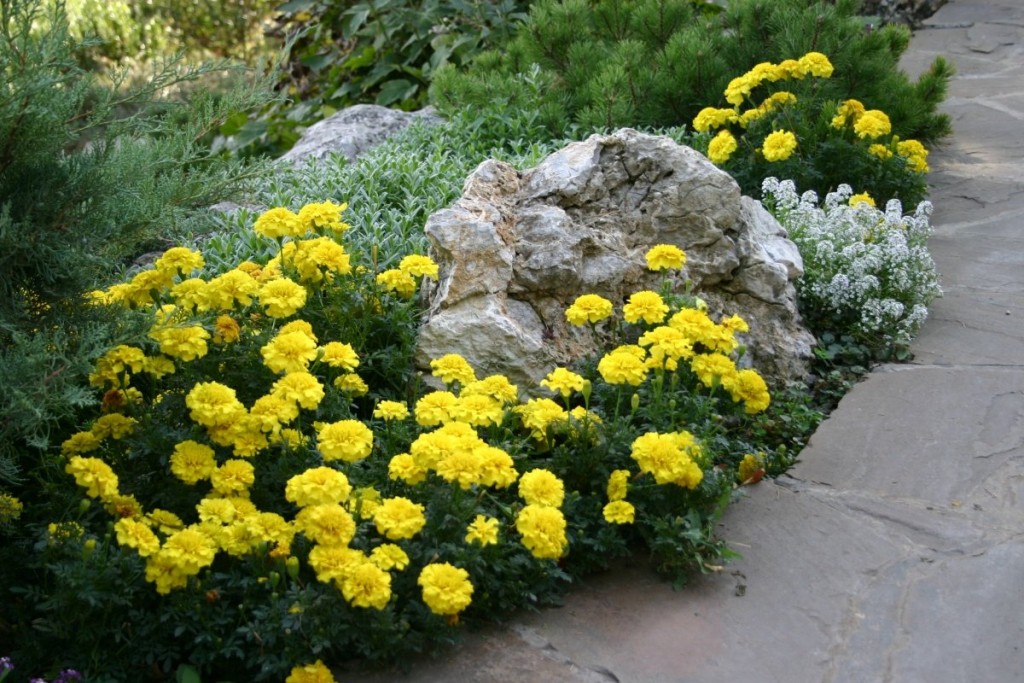
Bright colors can effectively fill the free space between stones on an alpine hill
In a natural and laid-back English square tagetis will bring a sunny mood. The Italian park, so pleasing with a riot of colors, the elegant look of these plants will add originality. In the direction of country, Turkish carnation is not only an element of landscape design: it heals the soil, and phytoncides secreted by the roots protect it from fungus and roundworms.

An original composition of blooming marigolds can decorate a garden of any style
Chernobrivtsi perfectly take root in containers. Flowers have excellent endurance, decorate with their buds installations of large and small sizes, growing in closed ground.

Marigolds feel great in pots, containers or stone flower pots
A composition consisting of several flower beds looks spectacular, where each is seeded with plants of the same species of the same color and height. They can be arranged both on the same level, and in a cascade. Be sure to use marigolds in the garden, photos and design confirm the need for their use to create landscape design of any complexity.

Mono-flowerbed is made up of one or more varieties of marigolds
Mixborder (translated from English as “mixed border”) - a combination of different groups of representatives of the flora in a composition, thought out by the harmony of colors and the order of flowering.
A combination of marigolds with other colors
There are some nuances when combining a variety of plant species and varieties, otherwise the result will not please:
- For comfortable growth and development, you need to carefully select the constituent flower beds - with the same requirements for lighting, soil composition and frequency of irrigation.
- It is important to take into account the size and shape so that the flowers do not interfere with each other - do not obscure or harm the root system.
- Know when the most magnificent blooming of buds will be.
- Do not forget about color, composing combinations of landscape design. It is advisable to avoid annoying variegation or boring options.
A wonderful idea is to make a composition of plants that change decorative qualities depending on the time of day. Some flowers will unfold under the bright sun, others in the evening or in cloudy weather. Then a multi-colored picture will change appearance several times a day. Marigolds get along well in the flower bed with any representatives of the flora - asters, petunias, phloxes, sage, viola, dahlias. It should not be planted next to roses - the "queen" will not tolerate such a neighborhood. It is also better to refrain from planting plants in the garden next to beans, peas and radishes.

It looks good flowerbed with rings of marigolds and petunias, in the center of which grow green bushes of kokhei
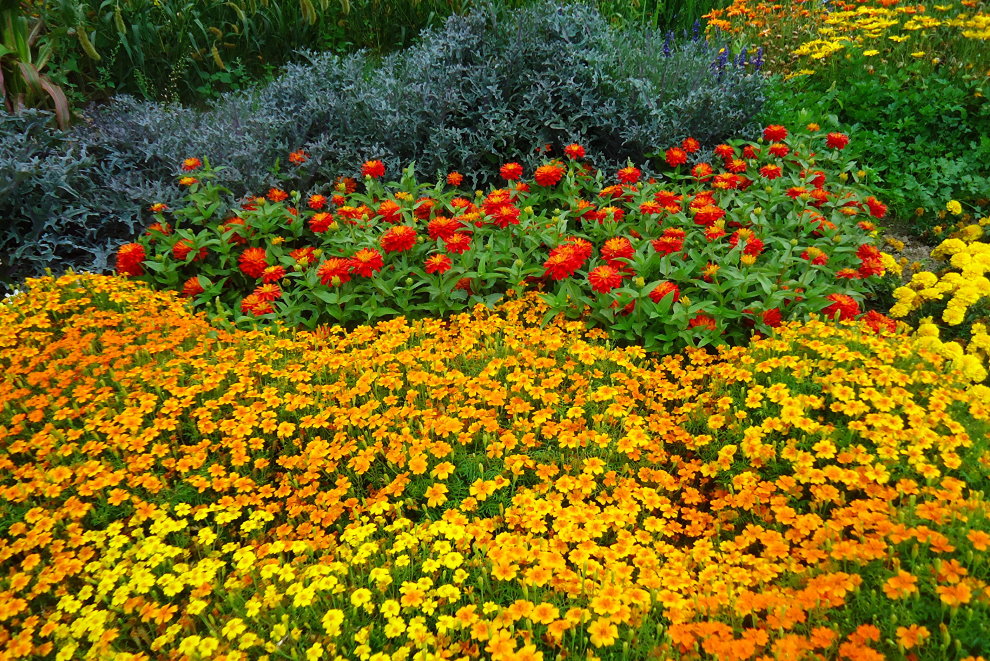
When planting together, you must take into account the height of the plants
With a little work and imagination, you will get an excellent result as in the photo of marigolds, and the presence of other flowers in the flower bed will be a pleasant memory of the past summer.
Landscaping tips and tricks
Caring for the Chernobrivtsy is a pleasure. They will please with magnificent blossoming of buds at the very minimum leaving.

Young marigolds need periodic watering and loosening of soil under the bushes
Care Rules:
- Although a plot of any illumination is suitable for effective growth, the most beautiful bushes will be on the sunny side of the flower bed.
- Regular watering is not necessary, since the plant is drought tolerant, but with a lack of water, the appearance will suffer - the lower leaves will dry out. Overfilling will cause stagnation of moisture and decay of the roots and stem.
- Top dressing is usually not required, however, if there is a desire, it should be carried out in stages. The first time - upon reaching the ten-centimeter length of the flower, the second - after the appearance of the buds, and the third - during the beginning of flowering. It is especially important to fertilize marigolds growing in closed ground.
- In order for the root system to "breathe", one should more often loosen the soil in the flowerbed with a small spatula or cultivator.
- If the bush is too bulky or you want to give it an interesting shape for landscape design, you can trim, which will update and activate growth.
- Remove wilted marigold buds, avoiding the appearance of seed bolls. Their maturation requires large plant resources, and this will adversely affect the appearance of the flowerbed.
- In rainy summers, when slugs and snails breed well, care must be taken especially painstakingly. These pests, drawing fragrant juices from buds, are scared away by the smell of bleach, the containers with which are placed among the flowers, regularly changing the contents. Frequent loosening of the soil will be required to provide ventilation to the roots.
- Marigold plantings can be struck by gray rot, which in a few days will turn a luxurious flowerbed into a miserable sight. Radical measures are required here. Affected plants should be uprooted and destroyed as soon as possible by burning on fire.
- On dry days, there is a danger of spider mites. To combat it, frequent spraying with water is used.If the moment is missed - among the foliage and buds on the flower bed there is a spider web, an infusion of a mixture of yarrow, onion and chili pepper will relieve the pest.
- The most common marigold disease is the black leg, which most often affects young flowers. A white coating appears on the lower part of the stem, which becomes darker and then rots. This can cause the death of the plant. To avoid trouble, you should treat the seeds and soil on the bed with fungicide before sowing, observing the measure.
There is nothing super complicated in the cultivation of the Blackbrivians. Their aesthetic appearance, which is combined with practical benefits, attracts the attention of gardeners and florists. Try to create a spectacular flowerbed of these flowers, a good option for decorating a house can be seen in the photo of the marigold buds in the landscape design of the suburban area.
Video: An Overview of the Best Marigold Varieties



